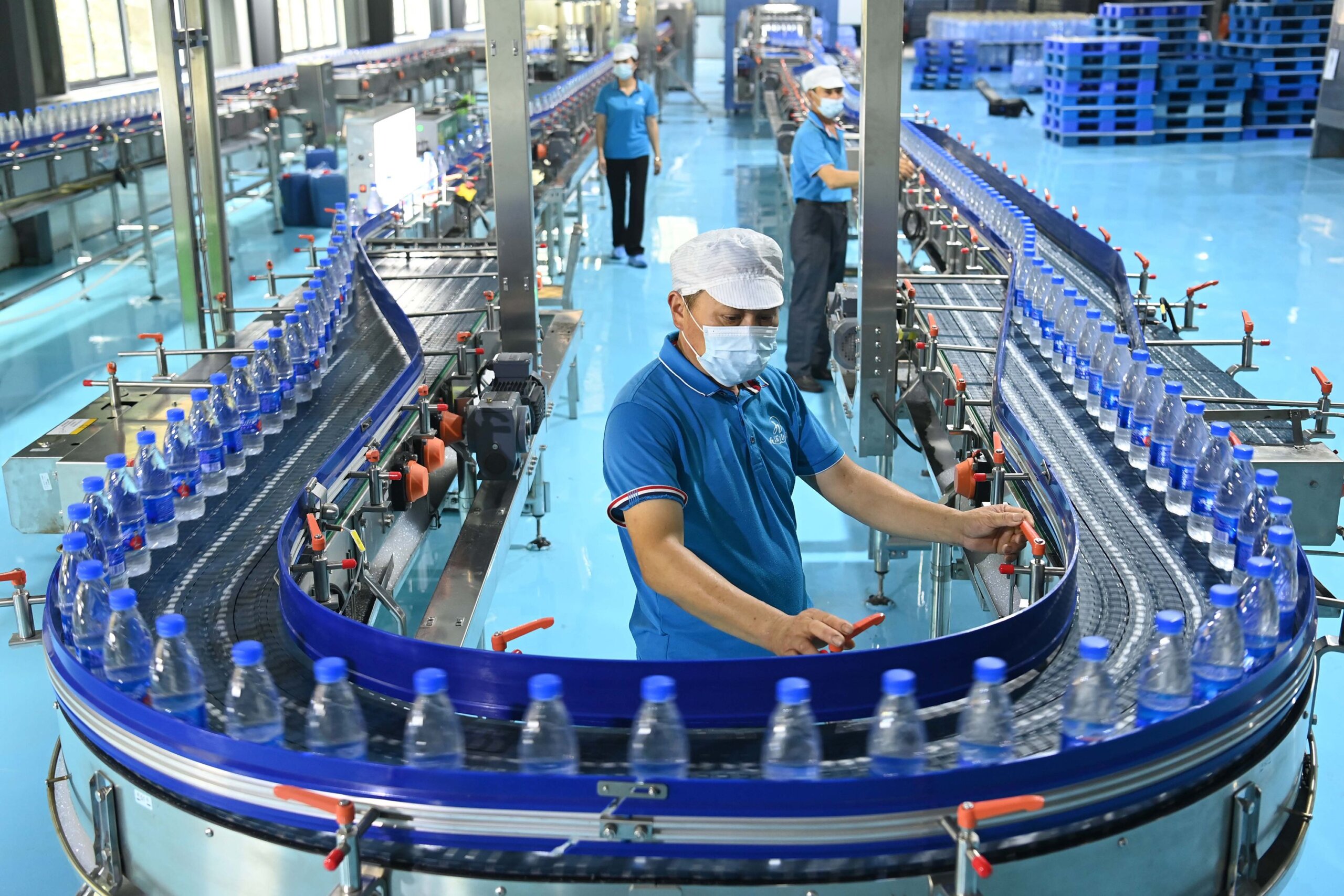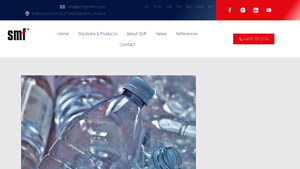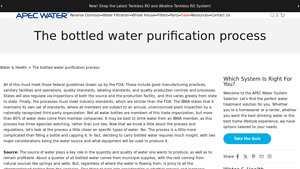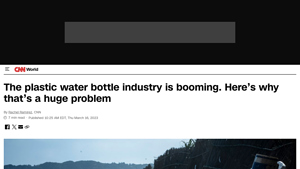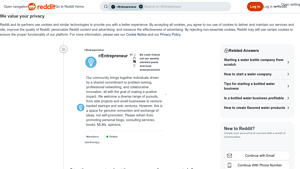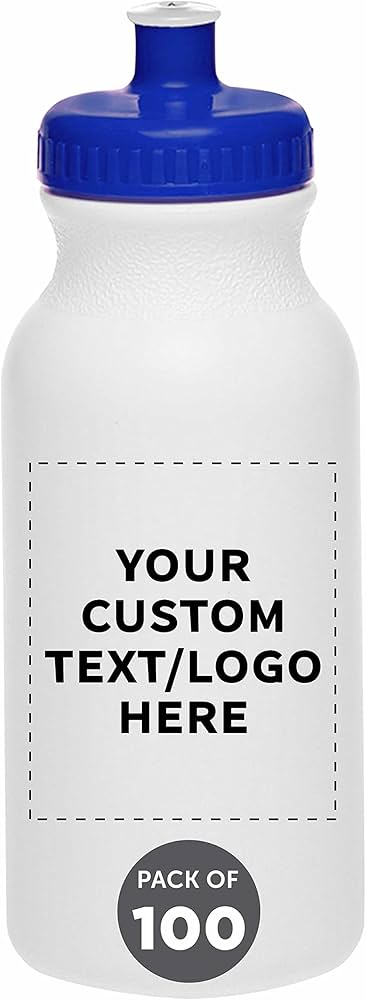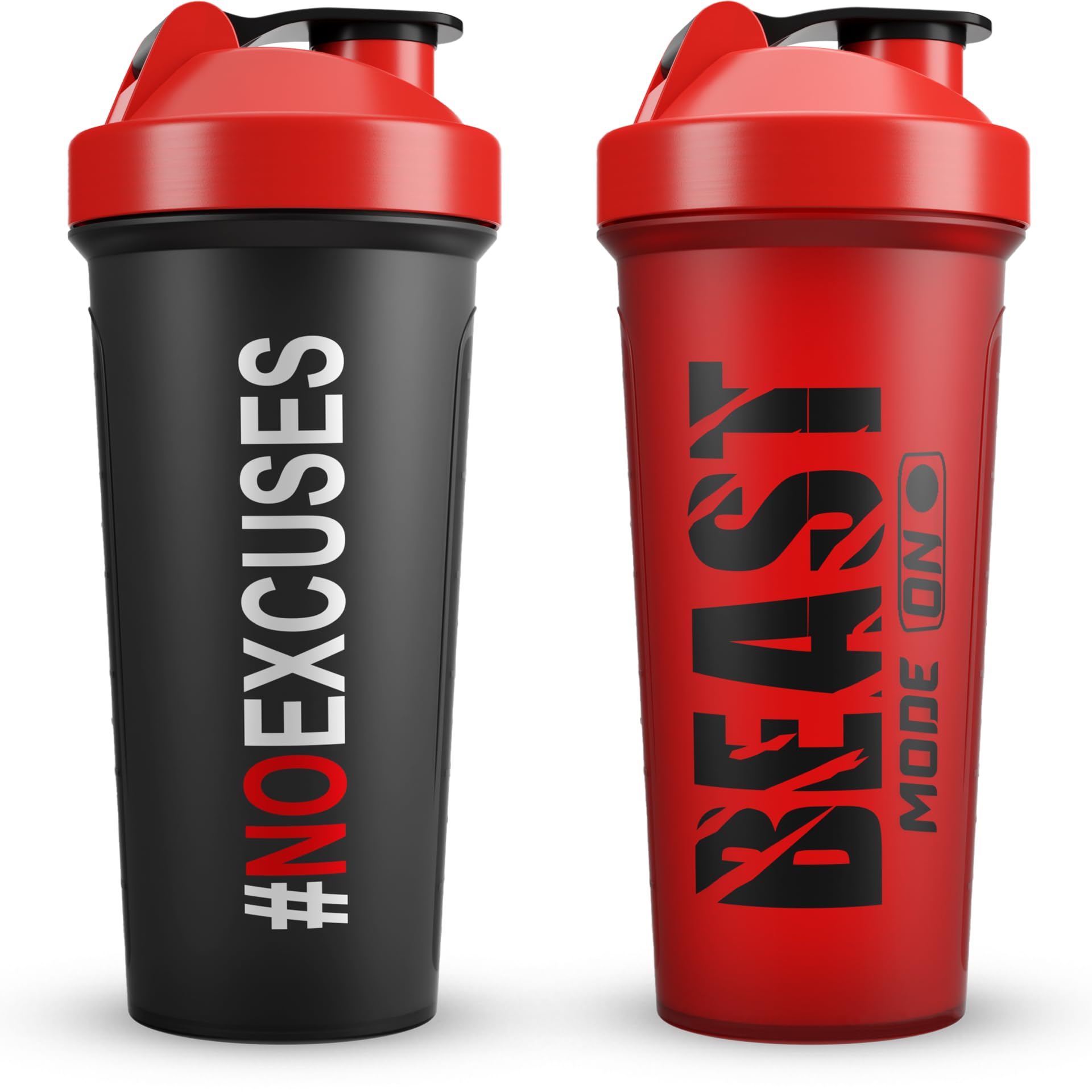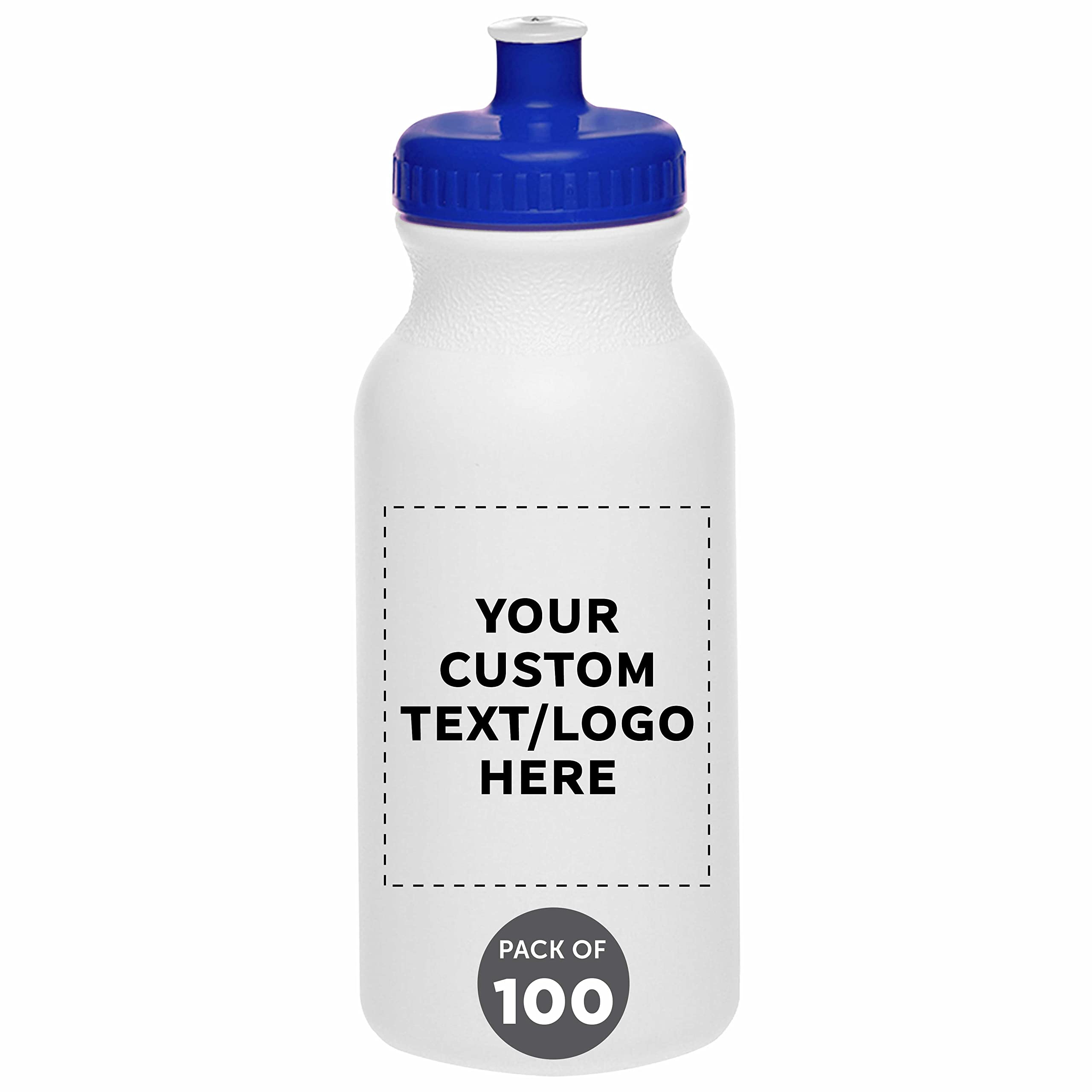Introduction: Navigating the Global Market for water bottle production
In today’s global marketplace, sourcing reliable and high-quality water bottle production can be a daunting task for international B2B buyers. The challenge lies not only in identifying the right materials and manufacturing processes but also in ensuring compliance with diverse regulations and sustainability standards. This comprehensive guide addresses these challenges by offering a detailed exploration of various types of water bottles, including Polyethylene Terephthalate (PET), High-Density Polyethylene (HDPE), and more. Each section delves into the specific applications, advantages, and limitations of these materials, equipping buyers with essential knowledge to make informed decisions.
Moreover, this guide goes beyond mere material selection. It provides actionable insights on supplier vetting processes, cost considerations, and industry best practices, tailored specifically for businesses in regions such as Africa, South America, the Middle East, and Europe, including key markets like Brazil and Nigeria. By leveraging the information contained within, B2B buyers can navigate the complexities of water bottle production with confidence, ensuring that their procurement strategies align with both operational needs and sustainability goals. Empower yourself to make educated purchasing decisions that not only meet your business requirements but also contribute positively to the environment and local economies.
Navegação de artigos
- Top 4 Water Bottle Production Manufacturers & Suppliers List
- Introduction: Navigating the Global Market for water bottle production
- Understanding water bottle production Types and Variations
- Key Industrial Applications of water bottle production
- 3 Common User Pain Points for ‘water bottle production’ & Their Solutions
- Strategic Material Selection Guide for water bottle production
- In-depth Look: Manufacturing Processes and Quality Assurance for water bottle production
- Practical Sourcing Guide: A Step-by-Step Checklist for ‘water bottle production’
- Comprehensive Cost and Pricing Analysis for water bottle production Sourcing
- Alternatives Analysis: Comparing water bottle production With Other Solutions
- Essential Technical Properties and Trade Terminology for water bottle production
- Navigating Market Dynamics and Sourcing Trends in the water bottle production Sector
- Frequently Asked Questions (FAQs) for B2B Buyers of water bottle production
- Aviso importante e termos de utilização
- Strategic Sourcing Conclusion and Outlook for water bottle production
Understanding water bottle production Types and Variations
| Tipo Nome | Principais caraterísticas distintivas | Aplicações B2B primárias | Breves prós e contras para os compradores |
|---|---|---|---|
| Polyethylene Terephthalate (PET) | Lightweight, transparent, strong, commonly used for beverages | Bottled water, soft drinks, juices | Prós: Cost-effective, durable, recyclable. Contras: Slightly permeable, may affect taste. |
| Polietileno de alta densidade (HDPE) | Strong, impact-resistant, versatile in shape and size | Milk, cleaning agents, personal care | Prós: Highly recyclable, durable. Contras: Low heat tolerance, limited high-temperature applications. |
| Polipropileno (PP) | Low-density, excellent thermoforming capabilities, can be made transparent | Pill bottles, food containers | Prós: Cost-effective, good chemical resistance. Contras: Generally less rigid than PET and HDPE. |
| Polycarbonate (PC) | Durable, high-temperature resistance, reusable | Refillable water bottles, food storage | Prós: Strong, transparent, reusable. Contras: Can leach BPA, more expensive. |
| Low-Density Polyethylene (LDPE) | Flexible, lightweight, squeezable | Personal care products, condiments | Prós: Easy to transport, user-friendly. Contras: Limited strength, not suitable for high-temperature applications. |
What Are the Characteristics of Polyethylene Terephthalate (PET) Bottles?
PET bottles are widely recognized for their lightweight and transparent properties, making them ideal for packaging beverages such as bottled water and soft drinks. They offer excellent durability and are cost-effective, providing an attractive option for B2B buyers looking to minimize shipping costs. However, their slight permeability can affect the quality of sensitive liquids, so buyers should consider their product’s storage requirements.
How Do High-Density Polyethylene (HDPE) Bottles Stand Out?
HDPE bottles are known for their strength and resistance to impact, making them suitable for a variety of applications, from milk containers to cleaning agents. Their versatility in shape and size caters to different packaging needs, and the material’s high recyclability is increasingly appealing to environmentally conscious buyers. However, HDPE’s low heat tolerance may limit its use in high-temperature environments, necessitating careful consideration of application needs.
In What Situations Are Polypropylene (PP) Bottles Used?
Polypropylene is an excellent choice for applications requiring lightweight and low-density bottles, such as pill containers and food packaging. Its thermoforming capabilities allow for versatile designs, catering to specific product requirements. While cost-effective and resistant to chemicals, B2B buyers should note that PP generally lacks the rigidity found in PET and HDPE, which may affect its suitability for certain applications.
Why Choose Polycarbonate (PC) Bottles for Reusable Solutions?
Polycarbonate bottles are designed for durability and high-temperature resistance, making them ideal for refillable water bottles and food storage solutions. Their transparency enhances product visibility, appealing to consumers. However, potential buyers must consider the health implications of BPA leaching, which has led to a decline in popularity among certain demographics. The higher cost may also be a consideration for B2B buyers.
What Are the Benefits and Limitations of Low-Density Polyethylene (LDPE) Bottles?
LDPE bottles offer flexibility and lightweight characteristics, making them ideal for packaging personal care products and condiments. Their squeezable nature enhances user experience, making them a popular choice for lotions and sauces. However, LDPE’s limited strength and heat resistance can restrict its applications, prompting buyers to evaluate their specific packaging needs before making a procurement decision.
Key Industrial Applications of water bottle production
| Indústria/Setor | Specific Application of Water Bottle Production | Valor/benefício para a empresa | Principais considerações de fornecimento para esta aplicação |
|---|---|---|---|
| Beverage Industry | Bottling of Mineral Water | High demand for portable hydration solutions, enhancing brand visibility and market reach. | Quality of PET or HDPE materials, compliance with food safety regulations, and sustainability practices. |
| Personal Care Products | Packaging for Shampoo and Lotion | Attractive packaging can drive consumer preference and brand loyalty. | Flexibility and durability of LDPE, customization options, and recyclability of materials. |
| Food Service | Single-Use Bottles for Events and Catering | Convenience for consumers, promoting hygiene and ease of use during events. | Cost-effectiveness, availability of various sizes, and quick turnaround times for production. |
| Chemical Industry | Storage and Transport of Cleaning Agents | Robust packaging that ensures safety and compliance with regulations. | Chemical resistance of materials, adherence to safety standards, and bulk sourcing options. |
| Retail and E-commerce | Refillable Water Bottles | Encourages sustainability and brand differentiation in a competitive market. | Quality of reusable materials, design options for branding, and compliance with environmental regulations. |
How is Water Bottle Production Used in the Beverage Industry?
Water bottle production plays a crucial role in the beverage industry, particularly for bottling mineral water. The high demand for convenient hydration solutions drives the need for lightweight, transparent, and durable PET bottles. These bottles not only enhance brand visibility but also ensure product safety and quality. International buyers should consider sourcing materials that comply with stringent food safety regulations and prioritize sustainability to appeal to environmentally conscious consumers.
What is the Role of Water Bottle Production in Personal Care Products?
In the personal care sector, water bottle production is essential for packaging items like shampoos and lotions. The use of flexible and durable LDPE bottles allows brands to create attractive packaging that enhances consumer appeal. This can lead to increased brand loyalty and higher sales. Buyers in this sector should focus on customization options and the recyclability of materials, which are increasingly important for eco-conscious consumers.
How Does Water Bottle Production Benefit the Food Service Industry?
The food service industry utilizes water bottle production for single-use bottles in events and catering services. These bottles offer convenience and hygiene, making them ideal for large gatherings. Businesses benefit from the cost-effectiveness and variety of sizes available in the market. Buyers should prioritize sourcing options that ensure quick turnaround times and compliance with health regulations, which are critical for maintaining service quality.
What is the Importance of Water Bottle Production for the Chemical Industry?
In the chemical industry, water bottle production is vital for safely storing and transporting cleaning agents. The use of robust materials that resist chemical reactions is crucial for compliance and safety. Buyers in this sector must consider the chemical resistance of materials and ensure that they adhere to safety standards to prevent any hazardous incidents. Bulk sourcing options can also help in managing costs effectively.
How Does Water Bottle Production Support Retail and E-commerce?
Water bottle production is increasingly important in retail and e-commerce, particularly for refillable water bottles. This trend promotes sustainability and differentiates brands in a competitive market. Businesses can capitalize on this by offering high-quality, reusable materials that appeal to eco-conscious consumers. Buyers should focus on the design options available for branding and ensure compliance with environmental regulations to align with consumer expectations.
3 Common User Pain Points for ‘water bottle production’ & Their Solutions
Scenario 1: Navigating Quality Control in Production
O problema: One of the most pressing challenges faced by B2B buyers in water bottle production is ensuring consistent quality across batches. In many cases, variations in raw materials, manufacturing processes, or even supplier standards can lead to discrepancies in bottle integrity, clarity, or taste retention. This inconsistency can result in product recalls, damaged brand reputation, and financial losses, especially in markets where consumer trust is paramount.
A solução: To mitigate quality control issues, B2B buyers should implement a robust quality assurance (QA) program. This involves establishing strict specifications for raw materials, including certifications from suppliers that guarantee compliance with industry standards. Additionally, buyers should invest in automated testing equipment to monitor bottle integrity, permeability, and chemical leaching during production. Regular audits of the manufacturing process can also help identify potential quality pitfalls early. Collaborating closely with suppliers to maintain open lines of communication regarding material changes or production techniques can further enhance the stability of product quality.
Scenario 2: Managing Supply Chain Disruptions
O problema: Global supply chain disruptions have become increasingly common, affecting the timely delivery of raw materials needed for water bottle production. This can lead to production delays, increased costs, and ultimately, a failure to meet customer demand. For B2B buyers, especially those operating in fast-paced markets, these disruptions can threaten their competitive edge and market presence.
A solução: To counteract supply chain vulnerabilities, B2B buyers should diversify their supplier base. Instead of relying on a single source for critical materials like PET or HDPE, establishing relationships with multiple suppliers can provide more flexibility and reliability. Buyers can also explore local suppliers to reduce shipping times and costs, which can be particularly advantageous in regions like Africa and South America, where logistics can be challenging. Additionally, implementing inventory management systems that utilize predictive analytics can help forecast demand and adjust orders proactively, ensuring a smoother production flow even amid uncertainties.
Scenario 3: Adapting to Regulatory Compliance
O problema: Compliance with local and international regulations regarding plastic use, recycling, and food safety is a significant concern for B2B buyers in water bottle production. Regulations can vary widely between regions, and failing to adhere to these can lead to legal repercussions, financial penalties, and a tarnished brand image. In markets like Europe, where environmental regulations are stringent, this challenge is particularly pronounced.
A solução: B2B buyers should prioritize staying informed about the regulatory landscape by engaging with industry associations and legal experts who specialize in packaging compliance. Conducting regular training for procurement and production teams on the latest regulations is also essential. When sourcing materials, buyers should favor suppliers who provide transparent documentation regarding the compliance of their products with relevant regulations. Additionally, adopting sustainable practices, such as utilizing recycled materials or developing biodegradable options, can not only help meet regulatory requirements but also enhance brand reputation among environmentally conscious consumers. By taking these proactive steps, buyers can navigate compliance challenges more effectively and position their brands as leaders in sustainability.
Strategic Material Selection Guide for water bottle production
What Are the Key Properties of Common Materials Used in Water Bottle Production?
When selecting materials for water bottle production, it is essential to consider various factors that influence performance, safety, and cost. Below, we analyze four common materials: Polyethylene Terephthalate (PET), High-Density Polyethylene (HDPE), Polypropylene (PP), and Polycarbonate (PC). Each material has distinct properties that can significantly impact the final product’s suitability for different markets, particularly in regions like Africa, South America, the Middle East, and Europe.
How Does Polyethylene Terephthalate (PET) Perform in Water Bottle Applications?
PET is the most widely used material for water bottles due to its favorable properties. It has a temperature rating of up to 60°C and is resistant to impact, making it suitable for various beverage applications. The primary advantages of PET include its lightweight nature, which reduces shipping costs, and its excellent clarity, allowing consumers to see the product inside. However, PET is slightly permeable, which can lead to the degradation of water quality over time.
For international buyers, compliance with standards such as ASTM and ISO is crucial, especially in regions like Brazil and Nigeria, where regulatory scrutiny may be higher. The cost of PET is relatively low, making it an attractive option for mass production.
What Are the Benefits and Limitations of High-Density Polyethylene (HDPE)?
HDPE is another popular choice for water bottle production, particularly for larger containers. It boasts a higher temperature resistance than PET, withstanding temperatures up to 120°C, and is highly resistant to chemicals. This makes HDPE suitable for a wide range of applications, including those involving harsher liquids.
The main advantages of HDPE include its durability and recyclability, which align well with global sustainability trends. However, it has lower transparency compared to PET, which may affect consumer perception in markets that value product visibility. For buyers in regions like the Middle East, where temperature fluctuations can be significant, HDPE’s heat resistance is a critical factor. Its cost is generally moderate, making it a viable option for both budget-conscious and quality-focused producers.
How Does Polypropylene (PP) Compare in Terms of Performance and Cost?
Polypropylene is often used for reusable water bottles due to its excellent chemical resistance and ability to withstand high temperatures (up to 100°C). It is lightweight and can be produced in various colors, enhancing branding opportunities. However, PP is less impact-resistant than PET and HDPE, making it less suitable for single-use applications.
For international buyers, particularly in Europe, compliance with food safety regulations is paramount. PP’s recyclability also aligns with increasing environmental regulations. The cost of polypropylene is generally low, making it an attractive option for manufacturers looking to balance quality and affordability.
What Advantages Does Polycarbonate (PC) Offer for Water Bottle Production?
Polycarbonate is known for its high impact resistance and clarity, making it a preferred choice for high-end reusable water bottles. It can withstand temperatures up to 120°C and is highly durable, which is beneficial for long-term use. However, concerns about chemical leaching, particularly BPA, have led to a decline in its popularity for food and beverage applications.
For B2B buyers, especially in regions like South America, where health standards are becoming stricter, it is essential to consider the implications of using PC. Compliance with local regulations regarding BPA is crucial. The cost of polycarbonate is typically higher than that of PET and HDPE, which may limit its use to premium markets.
Summary Table of Material Selection for Water Bottle Production
| Material | Typical Use Case for water bottle production | Vantagem chave | Principal desvantagem/limitação | Custo relativo (baixo/médio/alto) |
|---|---|---|---|---|
| Polyethylene Terephthalate (PET) | Single-use beverage bottles | Lightweight and transparent | Slightly permeable | Baixa |
| Polietileno de alta densidade (HDPE) | Larger containers, chemical-resistant bottles | Durable and recyclable | Lower transparency | Med |
| Polipropileno (PP) | Reusable water bottles | High chemical resistance and lightweight | Less impact-resistant | Baixa |
| Polycarbonate (PC) | High-end reusable water bottles | Elevada resistência ao impacto e clareza | Chemical leaching concerns (BPA) | Elevado |
This strategic material selection guide serves as a valuable resource for B2B buyers, helping them navigate the complexities of water bottle production materials while considering regional standards and consumer preferences.
In-depth Look: Manufacturing Processes and Quality Assurance for water bottle production
What Are the Main Stages in Water Bottle Manufacturing?
The production of water bottles involves several distinct stages, each critical to ensuring the final product meets quality and safety standards. Understanding these stages can help B2B buyers make informed decisions when sourcing from manufacturers.
Material Preparation: What Materials Are Used?
Water bottles are predominantly made from various types of plastics, with Polyethylene Terephthalate (PET) being the most common due to its lightweight, durability, and recyclability. Other materials like High-Density Polyethylene (HDPE) and Polypropylene (PP) may also be utilized depending on the intended use of the bottle.
The process begins with the selection of raw materials, which are often sourced from suppliers who provide high-quality resin. This resin must undergo quality checks to ensure it meets necessary specifications. For instance, PET resin is polymerized from ethylene glycol and terephthalic acid, and the integrity of this polymerization process is essential for producing bottles that do not leach harmful chemicals into the water.
Como são formadas as garrafas de água?
The formation of water bottles typically involves several key techniques:
-
Moldagem por injeção: This technique creates preforms, which are small, test-tube-like structures made from heated plastic. The preform is then cooled and stored until needed.
-
Moldagem por sopro: The preform is reheated and inflated into the final bottle shape. This process can be either extrusion blow molding or injection blow molding, depending on the desired specifications of the bottle.
-
Thermoforming: For certain applications, sheets of plastic can be heated and molded into the desired shape, which is common for lids and caps.
Each of these techniques requires precise machinery and skilled operators to ensure consistency and quality throughout the production process.
What Is Involved in the Assembly and Finishing of Water Bottles?
Once the bottles are formed, they go through an assembly and finishing stage. This may include adding features like labels, caps, and tamper-evident seals.
Quality control is crucial at this stage to ensure that all components fit correctly and that the final product is aesthetically pleasing. Automated systems are often employed to streamline assembly, but manual inspection is also common to catch any defects that machines may miss.
What Quality Assurance Standards Should B2B Buyers Look For?
Quality assurance is a critical factor in water bottle production, particularly for B2B buyers who must ensure their suppliers meet international standards.
Which International Standards Apply to Water Bottle Production?
ISO 9001 is the most recognized quality management standard and is applicable to any organization, including those in the manufacturing sector. Compliance with ISO 9001 indicates that a supplier has established a quality management system that meets customer and regulatory requirements.
Additionally, industry-specific certifications may be relevant, such as:
- Marcação CE: Required for products sold in the European Economic Area, indicating conformity with health, safety, and environmental protection standards.
- API Certification: Particularly important for suppliers dealing with pharmaceutical-grade water bottles.
What Are the Key QC Checkpoints in Water Bottle Manufacturing?
Quality control checkpoints are strategically placed throughout the manufacturing process to catch defects early. These include:
-
Controlo de qualidade de entrada (IQC): Raw materials are inspected upon arrival to ensure they meet specifications.
-
Controlo de qualidade durante o processo (IPQC): Checks are performed during production to monitor the manufacturing process and identify any deviations from standards.
-
Controlo de qualidade final (FQC): The finished bottles undergo rigorous testing to ensure they meet all quality and safety standards before shipment.
What Common Testing Methods Are Used in Water Bottle Quality Control?
Various testing methods are employed to ensure water bottles are safe for consumer use:
- Teste de fugas: Ensures that bottles do not leak under pressure.
- Impact Resistance Testing: Assesses how well bottles can withstand drops and impacts during transportation.
- Testes químicos: Checks for the presence of harmful substances that could leach into the water.
- Microbial Testing: Ensures that the bottles are free from harmful bacteria and contaminants.
Como podem os compradores B2B verificar as práticas de controlo de qualidade dos fornecedores?
B2B buyers should take proactive steps to verify the quality control practices of potential suppliers:
-
Realizar auditorias: Regular audits can provide insights into the supplier’s manufacturing processes and adherence to quality standards.
-
Solicitar relatórios de qualidade: Suppliers should be willing to provide documentation that details their quality control processes and results from recent testing.
-
Utilize Third-Party Inspection Services: Engaging third-party inspectors can provide an unbiased assessment of the supplier’s operations and product quality.
Quais são as nuances do controlo de qualidade para os compradores internacionais B2B?
When sourcing water bottles from international suppliers, particularly from regions like Africa, South America, the Middle East, and Europe, buyers should be aware of potential variations in quality control practices.
-
Diferenças regulamentares: Each region may have its own set of regulations governing food and beverage packaging. Understanding these can help buyers avoid compliance issues.
-
Cultural Expectations: The perception of quality can vary significantly between cultures. B2B buyers should communicate clearly about their expectations and standards to ensure alignment.
-
Logística da cadeia de abastecimento: International shipping can introduce risks that affect product quality. It’s essential to work with suppliers who understand these challenges and have strategies in place to mitigate them.
By focusing on these critical aspects of manufacturing processes and quality assurance, B2B buyers can make informed decisions when partnering with water bottle manufacturers, ensuring they receive high-quality products that meet their needs and regulatory requirements.
Practical Sourcing Guide: A Step-by-Step Checklist for ‘water bottle production’
To assist international B2B buyers in navigating the complexities of water bottle production, this practical sourcing guide provides a comprehensive checklist. By following these steps, you can ensure a successful procurement process that meets your specific needs.
Passo 1: Definir as suas especificações técnicas
Before reaching out to suppliers, clearly outline your technical requirements for water bottles. Consider factors such as material (e.g., PET, HDPE), bottle size, shape, and intended use (single-use vs. reusable). This clarity will help you communicate effectively with potential suppliers and ensure that they can meet your specific needs.
Passo 2: Research Compliance and Regulations
Understanding local regulations and compliance standards is crucial, especially when exporting bottles to different regions. Investigate health and safety standards, food-grade certifications, and environmental regulations applicable in your target markets. Compliance not only ensures product safety but also enhances your brand’s reputation.
Passo 3: Avaliar potenciais fornecedores
Thorough vetting of suppliers is essential before making any commitments. Request detailed company profiles, production capabilities, and references from previous clients, particularly those in your industry or region. Look for suppliers with a proven track record in water bottle production to minimize risks associated with quality and reliability.
Passo 4: Assess Quality Control Measures
Inquire about the quality control processes implemented by potential suppliers. Effective quality control ensures that the bottles produced meet your specified standards. Ask about testing procedures for materials and finished products, and request documentation of certifications such as ISO standards or other industry-specific quality benchmarks.
Passo 5: Pedir amostras
Always request samples of the bottles you intend to procure. This allows you to evaluate the physical attributes, such as strength, weight, and design. Testing samples in real-world conditions can reveal potential issues that may not be apparent from specifications alone, ensuring that the product fits your requirements.
Passo 6: Negociar condições e preços
Once you have identified suitable suppliers, initiate negotiations regarding pricing, payment terms, and delivery schedules. Be clear about your budget constraints and the importance of cost-effectiveness while ensuring that quality is not compromised. Good negotiation can lead to better pricing agreements and long-term partnerships.
Passo 7: Establish a Logistics Plan
Finally, develop a logistics plan for transporting the bottles from the supplier to your location. Consider factors such as shipping costs, lead times, and customs regulations in your country. A well-thought-out logistics strategy will help you avoid delays and additional costs, ensuring a smoother procurement process.
By following this step-by-step checklist, B2B buyers can navigate the complexities of sourcing water bottle production effectively, ensuring that they select the right suppliers and products for their specific needs.
Comprehensive Cost and Pricing Analysis for water bottle production Sourcing
What Are the Key Cost Components for Water Bottle Production?
Understanding the cost structure of water bottle production is crucial for international B2B buyers aiming to source effectively. The primary cost components include:
-
Materiais: The choice of plastic significantly impacts costs. Polyethylene Terephthalate (PET) is commonly used due to its strength and lightweight properties, while High-Density Polyethylene (HDPE) is chosen for its durability and chemical resistance. Prices for these materials can fluctuate based on crude oil prices and market demand, so buyers should stay informed about global trends.
-
Trabalho: Labor costs vary widely based on geographical location. In regions like Africa and South America, labor may be more affordable than in Europe or the Middle East. However, the skill level required for quality production can also influence labor costs, as specialized skills may command higher wages.
-
Despesas gerais de fabrico: This includes costs associated with the manufacturing facility, utilities, and equipment maintenance. Advanced machinery, such as injection blow molding machines, may require significant capital investment but can lead to efficiencies in production and lower per-unit costs over time.
-
Ferramentas: Initial setup costs for molds and tooling can be substantial, particularly for custom bottle designs. The complexity of the mold design will affect the tooling costs, and these expenses are often amortized over large production runs.
-
Controlo de qualidade (CQ): Ensuring that bottles meet regulatory standards and customer specifications incurs costs. Investing in rigorous QC processes can prevent costly recalls and reputational damage.
-
Logística: Shipping and handling costs can vary based on distance, mode of transport, and the chosen Incoterms. For international buyers, understanding logistics is crucial to calculating the total cost.
-
Margem: Suppliers will include a profit margin that reflects their operational risk and investment. This margin can vary based on the supplier’s market position and product uniqueness.
What Factors Influence Pricing in Water Bottle Production?
Pricing in water bottle production is influenced by several key factors:
-
Volume/MOQ: The minimum order quantity (MOQ) can significantly affect pricing. Larger orders typically benefit from economies of scale, reducing the per-unit cost. International buyers should consider strategic partnerships to meet MOQs without excessive inventory.
-
Especificações e personalização: Custom bottle designs or specifications can increase costs due to the additional tooling and material requirements. Buyers should assess whether customization adds sufficient value to justify the increased expense.
-
Materiais: The type of plastic used not only affects the cost but also the environmental impact and recyclability of the bottles. Buyers should weigh the benefits of premium materials against their budget.
-
Qualidade e certificações: Bottles that meet specific quality standards or certifications (e.g., FDA approval, ISO certifications) may command higher prices. Buyers should ensure that the quality aligns with their market needs.
-
Factores do fornecedor: The reputation and reliability of suppliers can influence pricing. Established suppliers may offer higher prices but also provide better assurance of quality and delivery times.
-
Incoterms: Understanding Incoterms is essential for international buyers as they define the responsibilities of buyers and sellers in the shipping process. This can affect pricing, especially concerning who bears the cost of shipping and insurance.
What Tips Can Buyers Use to Negotiate Better Prices?
-
Negotiate Volume Discounts: Leverage bulk purchasing to negotiate better pricing. Suppliers are often willing to offer discounts for larger orders, which can significantly reduce overall costs.
-
Evaluate Total Cost of Ownership: Consider not only the purchase price but also long-term costs associated with quality, reliability, and shipping. A lower upfront cost may lead to higher expenses down the line if quality is compromised.
-
Explore Multiple Suppliers: Engaging with multiple suppliers can help in negotiating better terms and prices. Conducting thorough market research can help identify competitive pricing.
-
Understand Local Regulations: Buyers should be aware of import duties and local regulations that may affect pricing. This knowledge can be advantageous during negotiations.
-
Criar relações: Establishing strong relationships with suppliers can lead to better pricing and terms over time. Trust and reliability can often lead to preferential treatment in pricing.
Conclusão
Navigating the cost and pricing landscape of water bottle production requires a comprehensive understanding of the various components and influencers at play. By leveraging strategic negotiation tactics and being aware of the total cost of ownership, international B2B buyers can make informed purchasing decisions that optimize their sourcing strategy. It is essential to remember that pricing can vary significantly based on numerous factors, and ongoing market analysis is critical for maintaining competitiveness.
Alternatives Analysis: Comparing water bottle production With Other Solutions
Understanding Alternative Solutions to Water Bottle Production
As the demand for sustainable and efficient packaging solutions grows, B2B buyers must consider various alternatives to traditional water bottle production. This section analyzes water bottle production against viable alternatives, helping businesses make informed decisions regarding their packaging needs.
Tabela de comparação
| Aspeto de comparação | Water Bottle Production | Reusable Water Bottles | Water Pouch Packaging |
|---|---|---|---|
| Desempenho | High durability and shelf life | Excellent for long-term use | Lightweight and space-efficient |
| Custo | Moderate to high production costs | Higher initial investment, lower long-term cost | Lower production costs |
| Facilidade de implementação | Established processes and technology | Requires consumer behavior change | Simple production process |
| Manutenção | Minimal after production | Requires cleaning and care | Generally single-use |
| Melhor caso de utilização | High-volume distribution | Eco-conscious consumers | Events, outdoor activities |
Análise pormenorizada das alternativas
Reusable Water Bottles
Reusable water bottles, typically made from stainless steel, glass, or durable plastics, offer a sustainable alternative to single-use water bottles. The primary advantage of reusable bottles lies in their long-term cost efficiency and environmental benefits, as they significantly reduce plastic waste. However, they require a higher upfront investment and necessitate a shift in consumer behavior towards regular cleaning and maintenance. Businesses targeting eco-conscious consumers or looking to enhance their sustainability efforts may find reusable bottles to be a compelling solution.
Water Pouch Packaging
Water pouch packaging is an innovative alternative that utilizes flexible, lightweight pouches instead of rigid bottles. This solution is particularly advantageous for outdoor events or activities where portability is essential. Water pouches offer lower production costs and are easier to transport due to their space-efficient design. However, they are generally intended for single-use applications, which may not align with sustainability goals. Companies looking for cost-effective packaging for temporary use may find water pouch solutions to be an attractive option.
Conclusion: Choosing the Right Solution for Your Business Needs
When selecting the appropriate packaging solution, B2B buyers must consider their specific needs, including target audience, cost implications, and sustainability objectives. Water bottle production remains a reliable choice for high-volume distribution, while reusable water bottles cater to the growing demand for environmentally friendly options. On the other hand, water pouch packaging provides a practical solution for short-term use. By carefully evaluating these alternatives, businesses can align their packaging strategies with their operational goals and consumer expectations.
Essential Technical Properties and Trade Terminology for water bottle production
What Are the Key Technical Properties in Water Bottle Production?
Understanding the essential technical properties involved in water bottle production is crucial for B2B buyers to make informed purchasing decisions. Here are some critical specifications that impact production quality and cost:
1. Grau do material
The grade of plastic used in bottle production significantly affects the product’s performance and safety. Common materials include Polyethylene Terephthalate (PET), High-Density Polyethylene (HDPE), and Polypropylene (PP). Each material has unique properties, such as strength, flexibility, and recyclability. Selecting the right material grade ensures compliance with safety regulations and meets customer expectations for product durability and usability.
2. Tolerance
Tolerance refers to the allowable deviation from specified dimensions in the manufacturing process. It is essential for ensuring that bottles fit standard caps, labels, and packaging systems. Tight tolerances can reduce waste and enhance the efficiency of the bottling process, which is especially important in high-volume production runs. Understanding tolerance requirements helps buyers specify their needs clearly to manufacturers.
3. Permeability
This property measures the ability of a material to allow gases or liquids to pass through it. For water bottles, low permeability is critical to maintain the integrity and taste of the bottled water. High permeability can lead to contamination and product spoilage, making it a vital specification for buyers focusing on quality assurance and product safety.
4. Impact Resistance
Impact resistance indicates how well a bottle can withstand physical shocks during handling and transportation. This property is particularly important for international shipments, where bottles may be subjected to rough conditions. A higher impact resistance translates to fewer breakages and lower costs related to product returns or replacements.
5. UV Resistance
This property determines a bottle’s ability to withstand ultraviolet light exposure without degrading. UV resistance is crucial for products that may be stored in direct sunlight, as it helps maintain the quality and safety of the contents. Buyers should consider this specification when sourcing bottles for outdoor or long-term storage applications.
What Are Common Trade Terms in Water Bottle Production?
Familiarity with industry terminology is essential for effective communication and negotiation between buyers and suppliers. Here are some commonly used trade terms:
1. OEM (Fabricante de equipamento original)
An OEM refers to a company that produces parts or products that are used in another company’s end product. In the context of water bottle production, an OEM may manufacture the bottles themselves or the machinery used to create them. Understanding OEM relationships can help buyers identify potential suppliers who offer custom solutions.
2. MOQ (Quantidade mínima de encomenda)
MOQ is the smallest quantity of a product that a supplier is willing to sell. This term is particularly important for B2B buyers, as it impacts inventory management and cash flow. Buyers should evaluate MOQs in relation to their sales forecasts to ensure they are not over-committing resources.
3. RFQ (Pedido de Cotação)
An RFQ is a document used by buyers to solicit price quotes from suppliers. It typically includes specifications, quantities, and delivery timelines. Providing a detailed RFQ helps suppliers give accurate estimates, facilitating better negotiations and ensuring that buyers receive competitive pricing.
4. Incoterms (Termos Comerciais Internacionais)
Incoterms are a set of predefined international rules that clarify the responsibilities of buyers and sellers in global trade. These terms cover aspects such as shipping costs, risk transfer, and delivery obligations. Understanding Incoterms is crucial for B2B buyers engaged in international transactions, as they can significantly affect the overall cost and logistics of procurement.
5. Prazo de execução
Lead time refers to the total time it takes from placing an order until the product is delivered. This term is critical for inventory planning and ensuring timely product availability. Buyers should communicate their lead time requirements clearly to suppliers to avoid delays that could impact their operations.
By grasping these technical properties and trade terms, B2B buyers can navigate the complexities of water bottle production more effectively, leading to better purchasing decisions and successful partnerships.
Navigating Market Dynamics and Sourcing Trends in the water bottle production Sector
What Are the Key Market Dynamics and Trends Shaping Water Bottle Production?
The global water bottle production market is significantly influenced by various dynamics, including the rise in health consciousness, increasing environmental regulations, and the demand for convenient packaging solutions. As consumers prioritize hydration and convenience, there is a notable shift towards lightweight, portable options. This trend is particularly relevant for international B2B buyers from regions such as Africa, South America, the Middle East, and Europe, where urbanization is driving greater demand for bottled water.
Emerging technologies like automation in manufacturing processes and advancements in recycling methods are also reshaping the landscape. Automation reduces production costs and enhances efficiency, making it attractive for manufacturers to meet growing demand. Meanwhile, innovations in materials, such as biodegradable plastics and reusable bottle designs, are gaining traction as companies look to differentiate themselves in a crowded market.
Moreover, supply chain dynamics are evolving due to geopolitical shifts, particularly in sourcing raw materials. Buyers need to be aware of potential disruptions in supply chains, which can affect pricing and availability. For instance, sourcing high-density polyethylene (HDPE) and polyethylene terephthalate (PET) from stable suppliers is crucial to ensure consistent product availability while maintaining competitive pricing.
How Can Sustainability and Ethical Sourcing Impact Your Water Bottle Production Choices?
Sustainability is no longer a mere buzzword; it has become a critical consideration in water bottle production. The environmental impact of plastic waste is prompting B2B buyers to seek suppliers who prioritize sustainable practices. This includes using recycled materials and adopting eco-friendly production methods. For instance, sourcing PET made from recycled content not only reduces waste but also appeals to environmentally conscious consumers.
Ethical sourcing is equally important, as buyers increasingly demand transparency in their supply chains. Companies that can demonstrate responsible sourcing practices, including fair labor conditions and minimal environmental impact, are more likely to build trust with their clients. Certifications such as ISO 14001 for environmental management or Cradle to Cradle for sustainable product design can serve as vital indicators of a supplier’s commitment to sustainability.
Furthermore, the trend towards ‘green’ certifications is gaining momentum. Buyers should consider suppliers who hold certifications that align with their sustainability goals, as this can enhance brand reputation and customer loyalty. By prioritizing sustainability and ethical sourcing, B2B buyers can not only contribute to environmental conservation but also position themselves favorably in an increasingly eco-conscious market.
What Is the Historical Context Behind Water Bottle Production?
The production of water bottles has evolved significantly over the past few decades, driven by technological advancements and changing consumer preferences. Initially dominated by glass, the industry transitioned to plastics in the late 20th century due to their lightweight and durable nature. The introduction of PET in the 1970s revolutionized the sector, providing a cost-effective and versatile alternative for beverage packaging.
As environmental concerns grew, particularly in the 2000s, the focus shifted towards recycling and sustainability. This led to innovations in both materials and manufacturing processes, with an emphasis on reducing carbon footprints and increasing the recyclability of products. Today, the industry is at a pivotal point, balancing consumer demand for convenience with the urgent need for sustainable practices. Understanding this evolution helps B2B buyers appreciate the complexities of sourcing while navigating an ever-changing market landscape.
Frequently Asked Questions (FAQs) for B2B Buyers of water bottle production
-
How do I choose the right plastic material for water bottle production?
Selecting the appropriate plastic material is crucial for water bottle production. The most commonly used material is Polyethylene Terephthalate (PET) due to its lightweight, strong, and recyclable properties. For applications requiring higher durability, High-Density Polyethylene (HDPE) is recommended. If you need flexibility, Low-Density Polyethylene (LDPE) is a viable option. Consider factors such as the bottle’s intended use, shelf life, and recycling capabilities when making your choice. -
Quais são as quantidades mínimas de encomenda (MOQs) típicas para garrafas de água?
Minimum order quantities (MOQs) can vary significantly based on the supplier and the type of bottle you require. Generally, MOQs range from 1,000 to 10,000 units for standard designs. Custom designs or specialized bottles may have higher MOQs due to increased production costs and setup times. When negotiating with suppliers, it’s essential to clarify MOQs early in the discussion to ensure they align with your business needs. -
What customization options are available for water bottles?
Customization options for water bottles include size, shape, color, labeling, and printing. Many suppliers offer the ability to create bespoke designs that fit your branding requirements. Additionally, you can explore options like eco-friendly materials or unique closures. It’s advisable to communicate your specific needs during initial discussions with suppliers to ensure they can meet your customization requests. -
What quality assurance measures should I consider when sourcing water bottles?
Quality assurance (QA) measures are critical to ensure the safety and durability of water bottles. Look for suppliers who comply with international standards, such as ISO certifications. Request samples for testing, and inquire about their quality control processes, including inspections and testing for chemical leaching and structural integrity. Establishing clear QA guidelines in your contract can help mitigate risks associated with product defects. -
How can I vet potential suppliers for water bottle production?
Vetting suppliers is vital to ensure reliability and quality. Start by researching their reputation through reviews and industry ratings. Request references from previous clients and examine their production capabilities. Conduct factory visits if possible, and evaluate their compliance with regulatory standards. Additionally, consider their experience with international shipping and logistics, especially if you are sourcing from different continents. -
What payment terms are common in B2B water bottle production?
Payment terms can vary widely among suppliers but typically include options like upfront deposits, net 30/60/90 days, or letters of credit. Commonly, suppliers may request a 30% deposit before production and the remaining balance upon delivery. It’s essential to discuss payment terms upfront and ensure they fit your cash flow needs while protecting both parties in the transaction. -
Que considerações logísticas devo ter em conta ao importar garrafas de água?
When importing water bottles, logistics considerations include shipping methods, customs regulations, and delivery timelines. Choose between air freight for speed or sea freight for cost-effectiveness, depending on your urgency. Familiarize yourself with the import regulations of your country, including tariffs and documentation requirements. Collaborating with a logistics partner experienced in international trade can streamline the process and minimize delays. -
How do I ensure compliance with international regulations for bottled water?
Compliance with international regulations is crucial for bottled water. Familiarize yourself with the standards set by organizations such as the World Health Organization (WHO) and local health authorities in your target market. Ensure that your supplier adheres to food safety certifications, such as HACCP or GMP. Regularly audit your supply chain to maintain compliance and mitigate risks associated with non-compliance that could impact your business reputation.
Aviso importante e termos de utilização
⚠️ Declaração de exoneração de responsabilidade importante
As informações fornecidas neste guia, incluindo o conteúdo relativo a fabricantes, especificações técnicas e análises de mercado, destinam-se apenas a fins informativos e educativos. Não constitui aconselhamento profissional em matéria de aquisições, aconselhamento financeiro ou aconselhamento jurídico.
Embora tenhamos feito todos os esforços para garantir a exatidão e a atualidade das informações, não somos responsáveis por quaisquer erros, omissões ou informações desactualizadas. As condições de mercado, os detalhes da empresa e as normas técnicas estão sujeitos a alterações.
Os compradores B2B devem efetuar a sua própria diligência prévia independente e exaustiva antes de tomar qualquer decisão de compra. Isto inclui contactar diretamente os fornecedores, verificar as certificações, solicitar amostras e procurar aconselhamento profissional. O risco de confiar em qualquer informação contida neste guia é suportado exclusivamente pelo leitor.
Top 4 Water Bottle Production Manufacturers & Suppliers List
1. SMFG – Key Products
Domínio: smfgmbh.com
Registada: 2003 (22 anos)
Introdução: Key product details include: 1. PET Blow Machines: Optima electric PET blower, HS and Combi PET blower, 3L-20L big bottle blowers. 2. Filling lines and bottling lines. 3. Bottle Unscrambler Machine. 4. Conveyors and bottle handling systems: Air conveyor systems, Plate conveyors (single and multi-row). 5. Steam tunnel for PET bottles – blowing molds. 6. Bottle Filling Machines. 7. Paper decoration …
2. Apec Water – Bottled Water Purification
Domínio: apecwater.com
Registada: 2004 (21 anos)
Introdução: The bottled water purification process involves several key steps and regulations. Bottled water must meet federal guidelines set by the FDA, including good manufacturing practices, sanitary facilities, quality standards, and labeling standards. The International Bottled Water Association (IBWA) also imposes stricter industry standards, requiring annual inspections by third-party organizations for…
3. CNN – Bottled Water Industry Growth
Domínio: cnn.com
Registered: 1993 (32 years)
Introdução: The plastic water bottle industry is experiencing significant growth, with over 1 million bottles sold every minute globally. Sales of bottled water reached 350 billion liters in 2021, valued at approximately $270 billion, and are projected to rise to $500 billion by 2030. The industry has seen a 73% growth in sales from 2010 to 2020, making it one of the fastest-growing industries. The largest co…
4. Bottling Solutions – Production Insights
Domínio: reddit.com
Registada: 2005 (20 anos)
Introdução: This company, Bottling Solutions – Production Insights, is a notable entity in the market. For specific product details, it is recommended to visit their website directly.
Strategic Sourcing Conclusion and Outlook for water bottle production
How Can Strategic Sourcing Enhance Your Water Bottle Production?
In the dynamic landscape of water bottle production, strategic sourcing emerges as a pivotal factor in achieving competitive advantage. By leveraging high-quality materials such as PET, HDPE, and LDPE, businesses can ensure product durability, cost-effectiveness, and consumer appeal. Understanding the manufacturing processes, such as injection blow molding and the unique properties of various plastics, allows B2B buyers to make informed decisions that align with their operational goals.
Fostering relationships with reliable suppliers from diverse regions, including Africa, South America, the Middle East, and Europe, can streamline procurement and enhance supply chain resilience. As sustainability becomes increasingly essential, sourcing from environmentally responsible manufacturers not only meets regulatory demands but also resonates with eco-conscious consumers.
Looking ahead, the water bottle production market is poised for growth, driven by rising demand for convenient and portable hydration solutions. International B2B buyers are encouraged to explore innovative sourcing strategies that prioritize quality, sustainability, and cost efficiency. Embrace the future of water bottle production by investing in strategic partnerships that will propel your business forward in this evolving industry landscape.

